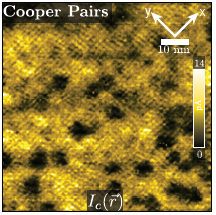Scanned Josephson Spectroscopy
Superconductivity is one of the most profound manifestations of many-body quantum mechanics ever to have been observed, and the levitation caused by the macroscopic persistent equilibrium currents seen in superconductors is one of the most striking examples of quantum physics in action. ‘Conventional’ superconductors were understood in the theory of Bardeen, Cooper and Schrieffer, but we now realize that their insights were only the tip of the iceberg. Whole new families of materials have been discovered in which the superconductivity has different, ‘unconventional’ origins. Although most superconducting states are spatially uniform, it is possible to have non-uniform order parameters and form what are now referred to as pair density waves. These are of particular topical significance because some of the highest temperature superconductors are thought to feature a unique interplay of uniform superconductivity, charge density waves and pair density waves. Understanding these states is likely to be key to understanding the microscopic origins of unconventional superconductivity. During a collaborative St Andrews-Cornell PhD project, Stephen Edkins performed the first ever imaging of a pair density wave, by adapting a millikelvin scanning tunneling microscope to have a tip made from a high temperature superconductor and tunneling Cooper pairs rather than single electrons. This breakthrough has laid the foundations for the development of an entirely new instrument, a scanning Josephson microscope.

This project will be to perform that development, investigating and understanding tips made from a variety of high temperature superconductors, and using them to study putative pair density wave states in a number of materials. The research will be demanding, but the rewards in terms of physics and new measurement technology will be considerable. The majority of the experimental work will be performed at the University of Oxford in the UK, so a sense of adventure and a willingness to travel are prerequisites for this project.
Background reading












